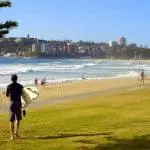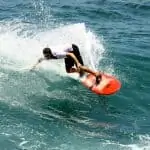5 Tips for Surfing Choppy Waves
Surfing has lots of days that are far from perfect, but to have fun, we still want to make the most of the conditions when we can and get some waves.
Tide, wind and swell rarely combine for perfect conditions for most of us, be it as weekend warriors, students, parents or all of the above!
This means that surfing on windy days in poor quality waves is an unavoidable part of the surfing experience for most.
With that in mind, below are 5 tips for surfing in choppy waves, and this is coming from a place of experience of many years surfing junk waves!
Before we start, there’s one point to make clear:
What are choppy waves in surfing? Choppy waves are waves that are messy and disorganized, usually as a result of very strong winds and are usually part of a windswell. This means that the waves have traveled a shorter distance than better quality swell and are closer together and harder to ride.
The way that these waves form means that they are not uniform and break irregularly and in many places at once, making for less-than-ideal but still very much surfable conditions.
When you see these kinds of waves, you can instantly understand why they are called ‘choppy’ as it looks like the sea has been chopped up or hacked with a knife!
So, with that done, let’s get into the tips right now!
Lower your Expectations
The first thing about surfing choppy waves is that you cannot compare them to perfect conditions.
A clean day of waves without wind may be the ideal surfing conditions, but small windswell with bumps on the face and waves breaking in all directions is much more common for most of us.
With that said, before paddling out on a day with choppy waves, remember this and try to forget the fact that the conditions are not ‘perfect’.
I know that I’ve had some of my most fun surfs in choppy conditions, with fewer people in the water I’ve often been to catch more waves and just get out and have fun where others would turn their nose up at it.
If you go out thinking that it’s just a bit of fun to catch a few waves then you shouldn’t have too much of an issue finding time to enjoy yourself!
If learning to surf, get a full run-down of the best conditions for learning to surf in this super helpful article I wrote on it!
Hide from the Wind
Choppy waves are the result of high winds and usually it will still be windy when it comes time to surf in these conditions.
Note that choppy waves and strong wind make for the hardest conditions to surf.
This is because the chop on the face of the wave makes the waves slower, as if they had speed bumps, while the wind can make it harder to balance on your board, especially when it comes in gusts.
So, try to find a headland or a cove that offers some protection from the full brunt of the wind, even if just a little.
This kind of protection won’t be enough to make the waves clean but it should help you to stay upright on your board that bit longer when riding.
Even if you can only find partial shelter from the wind, this should still be better than going to an exposed beach in strong winds.

Use the Right Type of Board
Choppy surf is also more fun if you have a board suited to the task.
Specifically, you want a board that is made from a traditional fiberglass polyurethane (PU) construction, a soft-top ‘foamie’ or one from wood.
This is in contrast to some of the more modern epoxy surfboards since these have
the construction, for reasons which I’ll explain below.
Fiberglass PU surfboards, soft-top foam boards or even wooden boards are better to ride in choppy conditions since they are better at ‘dampening’ the bumps and chop on the waves when up and riding.
This is due to their weight, density and solid construction.
Because they are heavier, fiberglass PU and wooden boards are better at riding through the chop, while their solid construction means that they mean you, as the rider, will feel less chatter when hitting bumps.
Contrast this with some of the super-light composite construction modern boards available today, which are extremely rigid and can send a feeling like shockwaves through your feet when you are riding.
I’ve experienced this when riding on my Santa Cruz Pumpkin Seed surfboard, which was an extremely fun boar but it definitely worked better in cleaner waves.
I can still remember the harsh feeling of the chatter under my feet as I rode over bumps and chop on the waves, which was not nice!
You might also notice that some of the extremely light composite construction boards are also harder to control in the wind since they offer less resistance, which is another thing I’ve experienced when riding my Firewire Chumlee surfboard in the Helium construction, a super lightweight surfboard.
So, in summary, remember that choppy surf can be very hard with light boards while heavier, bigger boards glide through the chop that much more.
Be sure to check my in-depth guide to the best beginner surfboard brands if you’re looking to buy a board!
Ride Like a Skateboard
To have fun in choppy waves, you’ll also need to have a bit of a change in mindset as the waves are just a bit more chaotic.
To that end, if you try to ride like you were on a skateboard, you will generate more speed and have more success when riding along a wave.
Although this might not always be possible, especially on bigger boards, you should try to ‘tic-tac’ to keep moving and to beat the chop.
If unsure, first imagine a clock face, with the 12 o’clock position as straight ahead.
From there, a tic-tac motion on a skateboard (and also surfboard) is just moving the nose of the board from about the 2 o’clock position to the 11 o’clock position, back and forth quickly to keep momentum. You can see this demonstrated on a skateboard in the video below:
Doing this will mean that your board doesn’t bog down in the chop on the surface of the waves and it will keep you flowing along the face of a wave.
Look for Ramps
Now, this one is more advanced but, if you are getting to a more intermediate level, you can also start to look for ‘ramps’ when you are next out in choppy surf.
This is because choppy waves come together in such crazy ways as to produce cross-waves that can then meet to form a steep and short ramp upwards.
These kinds of days are perfect for trying aerials, or just ‘airs’, if you are at that stage.
Air specialist surfers often talk about choppy, onshore wind days as being great since the board will stick to your feet when up in the air, as opposed to blowing away from you on an offshore day.
Again, airs are arguably the hardest thing to do in surfing, alongside getting barreled, so don’t be too hasty and try to run (or jump!) before you can walk – having the fundamentals in place will go a long way to helping you have fun in the surf, so come back to these moves later, when you are good and ready.
Related Questions
What causes choppy waves? Strong winds close in to shore that either form or ruffle the waves is the main cause of choppy surf. This means that they break in many directions all at once and often closeout more. However, with the tips here you can learn how to still have a lot of fun in choppy surf!
How do you stop nosediving while surfing? Sit further back on your board, keep your chest up and try to take off earlier. If you do all of these 3 things, you should avoid nosediving, although it may take some time to figure out all the points.
Of the 3 things to improve on, getting the right timing will likely take the longest time, so be patient and keep trying!
Just remember – nosediving is a normal part of learning to surf so you shouldn’t worry about it – it will get easier.







